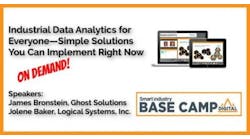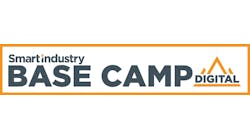Technology no constraint on digital transformation
By Paul Studebaker, editor in chief, Control Magazine
For digital transformation to really take off, radical new thinking about information technology must begin at the most basic levels, with new conceptions about how machines, information, people, systems and organizations will interact. What’s required, said Glen Allmendinger, president and founder, Harbor Research, in his keynote address at Smart Industry 2017, is the alignment of new technology, specifically a new “information architecture,” to inform radically new smart devices and interactions, with the corresponding “business/operations architecture” models these technologies inform.
For the first time in the evolution of networked businesses, these two “architectures” must be viewed in close proximity. To achieve the IIoT’s promise of digital transformation, the two thrusts need to be reinforce and support one another without interfering. “They need to be interwoven and mutually supportive,” said
Allmendinger. “In fact, from our own experiences, we believe success will increasingly goes to the company that effectively uses the combined potential of both.”
IT, OT cooperation needed
Convergence of IT and operational technology (OT) is an arms race that must end in cooperation. We must merge general-purpose and industrial computing. “For digital transformation to really take off,” Allmendinger said, “radical new thinking about information technology must begin at the most basic levels, with new conceptions about how machines, information, people, systems and organizations will interact.”
Digital innovation doesn’t start with choosing technology, he said. “It starts with a strategy and a plan for relating this new technology to organizational modes, relationships and interactions, to connect the physical world to information systems.” To develop that plan, Allmendinger recommends that you ask yourself these questions:
- How should we define and frame digital, IoT and smart systems?
- Where should we start this journey?
- What process and decision framework should we utilize?
- How should we think about architecture, both technology and business/operations?
- What success factors should we focus on?
Defining smart systems
“We are giving our world a digital nervous system,” Allmendinger said, with location data using GPS sensors, eyes and ears using cameras and microphones, and sensory organs that can measure everything from temperature to pressure changes. Sensing is robust and produces vast amounts of data. Networks must get more robust, with more wireless. The degree of data availability is what’s changed, Allmendinger said.
These inputs are digitized and placed onto networks, where people, data and analytics processes can then be combined into bidirectional systems that integrate them for better decision-making.
Where to start
As networks have invaded the physical world, traditionally unique components and interfaces between and among electronic and electromechanical elements are becoming more and more standardized. Almost anything becomes possible. “If there’s one competency that organizations must develop, it’s ‘how do I create more value?’ from the things they do,” Allmendinger said.
Simple applications include alerts and alarms, location services, monitoring and diagnostics and maintenance dispatch. Next up are applications such as asset management, multi-vendor equipment support and automation. “Here, you find multiple (peer-to-peer) devices and machines with significant interactions between systems and equipment in multi-vendor environments characterized by diverse vendors, users and stakeholders,” Allmendinger said.
Among the complex applications are smart manufacturing, smart supply chain and smart cities, “Applications driven by diverse interactions involving sensors, actuators, machines, people and systems that enable extending and expanding values from collaboration and analytics, supported by data fusion between and among disparate and diverse sources,” Allmendinger said.
“The world is stuck in what I would call simple apps—alarms and events,” Allmendinger said. We need to look at compound and complex applications, such as a truck in a cold chain. There, “I have sensors for data for compliance, condition monitoring, and direction finding for the driver--three systems running and sharing data across each other. Now we have different manufacturers sharing data across the applications. People don’t do that. That’s what must change.”
People start, but they don’t continue on the journey. “People get to first base--turbocharging operations, reducing cost—then they get drunk on margin and stop,” Allmendinger says. “They need to do more.”
Process and decision framework
A digital and IoT vision and strategy should be built on understanding new and novel requirements for manufacturing and customers. Development of new smart systems, services and solutions must be supported by new internal processes, skills and roles required to adopt the new technology and capabilities, which are in turn supported by building and sustaining partner and ecosystem values.
Building a framework is a cross-functional task. “Who understands it all? Not IT,” Allmendinger said. “It’s a hybrid role, an invented role that largely goes against the company’s conventional goals of ROI and cuts across disciplines, just like the way we need to cut across the plant systems: power, automation, plant, personnel.”
On architecture
We have the building blocks for the architecture we need, Allmendinger contends. These include extensible distributed systems; smart devices empowering the edge; mobile; cloud applications for unlimited asynchronous services; the ability to contextualize disparate data; analytics and machine learning; real-time supply chain visibility and intelligence for automation and control.
“We are the constraint, not the technology,” Allmendinger said. With artificial intelligence and machine learning, we can have timeline to completion and sense faults during production. Application development and developer tools allow us to build predictive maintenance and workflow applications. A distributed data and information architecture enables analytics on production processes and individual machines to improve efficiency.
High-performance networks synchronize global operations for collaboration and efficient management; sensors and sensor data fusion allow remote machine health and predictive maintenance/diagnostics. “Applications are nicely lined up,” Allmendinger says. “It’s in the organization where you have to develop the ability to leverage them.”
IoT solutions are not new. They are combinations of existing technologies based on knowledge of your business and information architecture. “Think of it as a map of where and how activities take place,” Allmendinger said. “Data will be connected and interoperable. Use the map to see where the value lies. Imagine the kinds of values that might come. You don’t know where the value might be until you build the map.”
Plan for success
“What success factors should we focus on, and then what next?” Allmendinger recommended the following five steps:
1. Focus on smaller projects early; drive quick wins and engagement.
2. Organize clever combinations of smart systems technologies.
3. Do rapid experimentation and systems innovation.
4. Extend skills through relationships, ecosystems and “strange bedfellows.”
5. Align your skills, capabilities and structure to support new technology adoption.
“It’s a different framework than what we’ve used to plan business in the past,” Allmenginger said. “It has nothing to do with the technology.”


